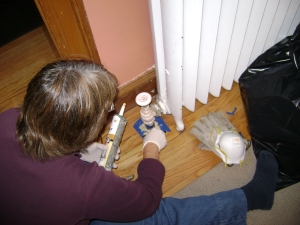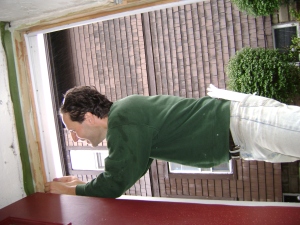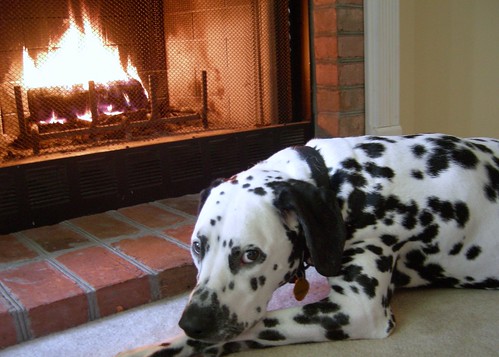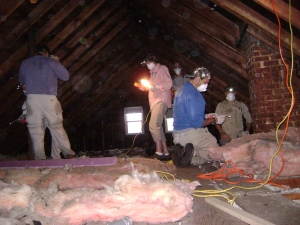Tag Archives: attic
Tired of paying someone to get rid of ice dams each year?
A lot of people are getting ice dams this year… a lot of people get ice dams every year.Why? In most cases it is due to a lack of insulation, air-sealing, or both. (Spoiler: If you want to read the best, and most detailed, piece on this I’ve seen, read Martin Holladay’s article on Green Building Advisor.)
If you call a roofer they will usually tell you to install “ice shield” under the shingles as a solution. As you’ll see, that’s kind of like telling you to take medication because you keep getting food poisoning at your favorite restaurant. Better, of course, is to stop eating there.
Up the chimney, all year long
Fireplaces can be great fun during the winter, providing ambiance and some added heat in the immediate vicinity. They can also be a huge waste of energy year-round. In weatherization we often talk about the “stack effect,” which is also commonly referred to as the “chimney effect.” In short (and greatly oversimplified), heat rises. During the winter warm air goes up and out through any and all holes. This is why sealing the attic is so important. Chimneys, however, are often overlooked. They are a huge heat loss during the winter and cool air during the summer, that is easy to fix and pays back immediately. Fireplaces and chimneys are straight shots from your climate controlled inside to the outside – a huge hole in your home’s ability to maintain the temperature you want. In the winter, whether you’ve got a fire raging or not, warm air goes up through the chimney outside, wasting energy and money. In the summer your cool air will do the same. Stopping that air flow is critical and usually, very easy. Usually the easiest way to stop the flow is with something called a “chimney balloon.” They are exactly what they sound like – a balloon you stick through your fireplace and into the chimney just above the flue. (You do have a flue, don’t you?) The most difficult thing is measuring your chimney interior to make sure you’ve got the correct fit. After that you inflate it the same way you do any balloon and it very effectively seals that hole but allows you to easily remove it if you want to build a fire in the winter. What happens though, if you can’t fit a chimney balloon? A few months ago we weatherized a home where the chimney was not only huge but had an irregular shape. A chimney balloon would not be able to seal this area. We didn’t want to give up though because this chimney was causing a huge waste of energy. We donned our thinking caps and came up with a cheap and easy solution that:
- Stops the air flow,
- Is removable if the owner wants to make a fire,
- Looks good.
All pieces were purchased at local hardware stores – the only technical skills required were cutting the plywood to size and measuring the spot, a dozen times. Check out the video below shot and edited by Martin LaMonica, and let us know if you’ve got other solutions to irregular spots. -Jeremy
One barnraising down, one entire town to go
September was our first “barnraising,” or weatherization event. Forty people came together on a cold rainy day to seal up a low-income two-family home run by the Housing Corporation of Arlington.

- We had forty people working on this house.
First floor unit:
We went from 3289 cfm to 2863 cfm – a decrease of 12.9%
Equivalent hole size was 327 square inches and went down to 270 square inches – a reduction of 17.4%
Second floor unit:
We went from 3532 cfm to 2668 cfm – a decrease of 24.4%
Equivalent hole size went from 352 square inches to 240 square inches – a reduction of 31.8%!!!!!!
This obviously doesn’t even include the reductions in energy usage that will be seen due to wrapping the pipes and water tanks, or electricity reduction due to the CFLs.
- A huge hole near chimney led to second unit’s closet. It was sealed with aluminum and stove paste.

- Regardless what we did the basement would be cold, and that was coming up to the first floor. We first filled the gap with rock wool (which can take high heats) as backer then capped it off with fire-barrier caulk. Blue tape is there to protect floor while working.

- Q-lon was already installed, wrong, by someone else. We fixed it. (Though I can’t fix this photo so it is vertical.)
>
> We went from 3289 cfm to 2863 cfm – a decrease of 12.9%
>
> Equivalent hole size was 327 square inches and went down to 270
> square inches – a reduction of 17.4%
>
>
>
> Second floor unit:
>
> We went from 3532 cfm to 2668 cfm – a decrease of 24.4%
>
> Equivalent hole size went from 352 square inches to 240 square
> inches – a reduction of 31.8%!!!!!!
>
>
>
> This obviously doesn’t even include the reductions in energy usage
> that will be seen due to wrapping the pipes and water tanks, or
> electricity reduction due to the CFLs.


